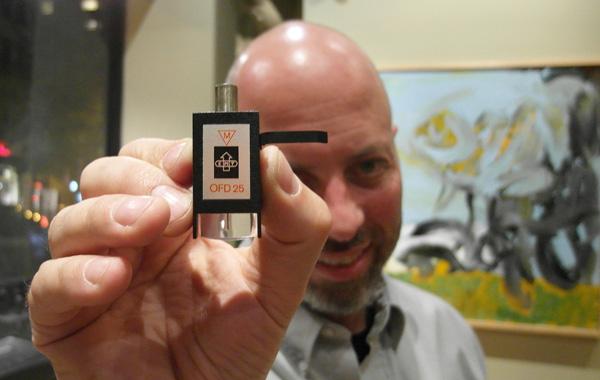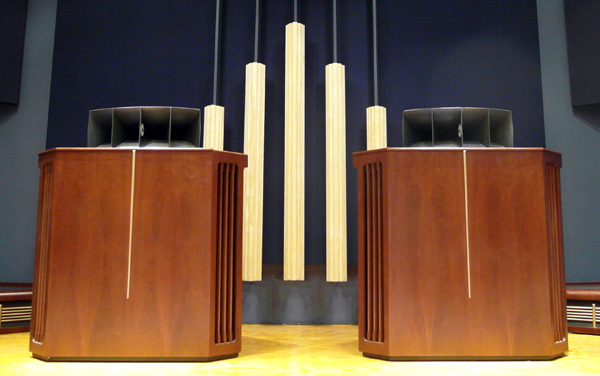| Columns Retired Columns & Blogs |
{Silly question?} Mono records will only play in speaker, correct?

On the evening of July 24, the passing of EMT's classic OFD series of pickup heads was noted in singular style: In Living Stereo, the hi-fi and record store that represents EMT in New York City, invited their customers to drop by for drinks, snacks, and the opportunity to hear their favorite mono LPs played with OFD 15 and OFD 25 pickups on an otherwise all-Shindo system: 301 turntable/tonearm ($30,000), Aurieges Phono EQ phono preamplifier, which includes a dedicated mono input transformer ($7895), Vosne-Romanee preamplifier ($19,900), Lafon GM 70 mono amplifiers ($21,995/pair), and a one-of-a-kind pair of Shindo Vitavox loudspeakers ($80,000/pair, pictured below), with Shindo silver interconnects, Auditorium 23 speaker cable, a Shindo Mr. T power distributor ($2000), and a Ligno Lab isolation rack.
The precise reason for the event: In response to dealer demand and under the direction of CEO Jules Limon, EMT scoured their factory and came up with enough parts to make one final run of 55 OFD pickups: a fitting number, given that the OFD design was introduced 55 years ago, in 1959. (The line is being phased out because the tooling for one component part—a small, seemingly insignificant nub of clear polycarbonate—was irreparably damaged, and the cost of replacing it is unlikely to be offset by future demand.) Of those 55 pickups, 18 are destined for the US, and while some are already spoken for, there now exists a chance to get hold of a brand new OFD 25i (with a 25µm spherical stylus tip that's suited for monophonic microgroove records) or OFD 65i (the 65µm stylus for 78rpm discs), both of whose output pins are aligned for the average SME-standard ("international") tonearm. A few samples of the same pickups with output pins aligned for old-style EMT tonearms are also being made. As the pickups are still in production, EMT and US importer Tone Imports have yet the establish the exact price, but it is estimated to be $2250 each.

For the ILS party, not all of the two dozen or so guests brought their own mono vinyl—but those who did shared some especially great records. Highlights included one of three volumes of Johanna Martzy's recordings of the Bach sonatas and partitas for solo violin, reissued by the Electric Recording Company, a lovely mono copy of Nat "King" Cole's Love is the Thing, and the very rare mono version of a title that most of us have heard only in stereo, Sonny Rollins's Way Out West. The latter's superior body, color, and impact—especially evident in Ray Brown's impeccable bass playing—was nothing short of stunning through the EMT/Shindo system.

{Silly question?} Mono records will only play in speaker, correct?

Hi Et Quelle. That's not a silly question at all. With a true mono cartridge such as an OFD -- which responds only to lateral groove modulations, and has only one coil (and two live output pins) -- the preamp may require a slight modification to allow the music signal to appear in both channels. One must sacrifice an unused pair of input jacks by disconnecting them from the input selector switch (let's say it was input #2); connect a lead from the selector switch's input #2 right-channel contact to the right-channel phono-input jack; and connect a jumper between the selector switch's input #2 right-channel contact to the same input's left-channel contact. Now input #2 is the preamp's mono phono input. (Please note that this is, effectively, not the same as a mono blend switch.)

Hi Art & Et Quelle
Feel free to correct me, but I would think that using a modified phono cable to present the mono signal to both channels of a stereo preamp would do the same as modifying the preamp. This would entail tying the "hot" output pin from the mono cartridge to both hot R + L signal wires of the cable. Caution would be required to not introduce a hum-causing ground loop - depending on the topology of the preamp (most tie R + L grounds together), which means that connecting only one shield wire to the other pin of the cartridge is required. Alternatively a "Y" adapter could do the trick.
Thoughts?
Thanks
---Josh

Hi Josh -- I believe you're correct. And your note of caution against ground loops (and/or other sources of interference) points to the reason for my fiddly approach of altering the wiring inside the preamp, and to why a mere mono blend switch won't do: Since one leg of the stereo tonearm cable is open at the cartridge end, you wouldn't want the resultant noise to get mixed in with the good mono signal from the other leg. Thanks for your observations!

Ray Brown always sounds great, and Roy Dunann really captured the the living, breathing sound of musicians in the room. BUT it is a travesty to split a mono signal into two speakers, that is gross spatial distortion not to mention comb filtering.

What about a kickstarter campaign to offset the cost of creating that missing component?
Seems like a good possibility to keep these fine cartridges in production!